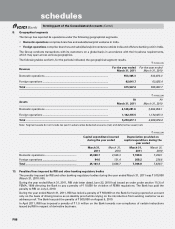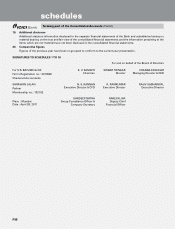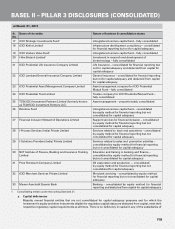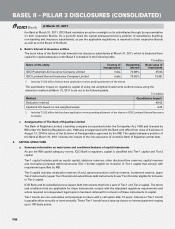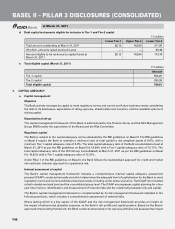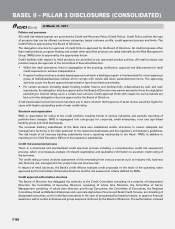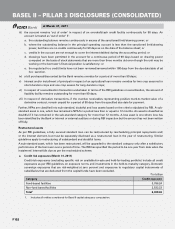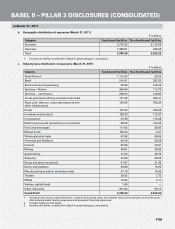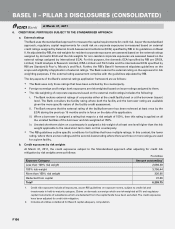ICICI Bank 2011 Annual Report Download - page 176
Download and view the complete annual report
Please find page 176 of the 2011 ICICI Bank annual report below. You can navigate through the pages in the report by either clicking on the pages listed below, or by using the keyword search tool below to find specific information within the annual report.
F98
b. Capital requirements for various risk areas (March 31, 2011)
As required by RBI guidelines on Basel II, the Bank’s capital requirements have been computed using the
Standardised approach for credit risk, Standardised Duration method for market risk and Basic Indicator approach
for operational risk. The minimum capital required to be held at 9.00% for credit, market and operational risks is
given below:
` in billion
Amount1
I. Capital required for credit risk 296.56
- for portfolio subject to standardised approach 294.82
- for securitisation exposure 1.74
II. Capital required for market risk 34.02
- for interest rate risk2 27.65
- for foreign exchange (including gold) risk 0.92
- for equity position risk 5.45
III. Capital required for operational risk 26.25
Total capital requirement (I+II+III) 356.83
Total capital funds of the Bank 789.63
Total risk weighted assets 3,964.78
Capital adequacy ratio 19.92%
1. Includes all entities considered for Basel II capital adequacy computation.
2. Includes capital required of ` 0.65 billion for securitisation exposure.
The capital ratios of the Bank and its banking subsidiaries at March 31, 2011 are as follows:
Capital ratios ICICI Bank Ltd
(consolidated)1
ICICI Bank Ltd
(standalone)1
ICICI Bank UK
PLC1
ICICI Bank
Canada1
ICICI Bank
Eurasia LLC1,2
Tier-1 capital ratio 12.72% 13.17% 14.11% 24.83% n.a.
Total capital ratio 19.92% 19.54% 23.07% 26.32% 34.64%
1. Computed as per capital adequacy guidelines issued by regulators of respective jurisdictions.
2. Tier-1 capital ratio is not required to be reported in line with regulatory norms stipulated by the Central Bank of Russia.
4. RISK MANAGEMENT FRAMEWORK
As a financial intermediary, the Bank is exposed to various types of risks including credit, market, liquidity, operational,
legal, compliance and reputation risks. The objective of the risk management framework at the Bank is to ensure that
various risks are understood, measured and monitored and that the policies and procedures established to address
these risks are strictly adhered to.
The key principles underlying the risk management framework at the Bank are as follows:
1. The Board of Directors has oversight on all the risks assumed by the Bank. Specific Committees of the Board have
been constituted to facilitate focused oversight of various risks. The Risk Committee reviews the risk management
policies in relation to various risks and the Bank’s compliance with risk management guidelines stipulated by the
RBI and of the status of implementation of the advanced approaches under the Basel framework. It reviews key risk
indicators covering areas such as credit risk, interest rate risk, liquidity risk, foreign exchange risk, operational and
outsourcing risks and the limits framework, including stress test limits for various risks. The Risk Committee also
reviews the risk profile of the overseas banking subsidiaries annually. Credit Committee reviews developments in
key industrial sectors and the Bank’s exposure to these sectors and various portfolios on a periodic basis. Audit
Committee provides direction to and also monitors the quality of the internal audit function.
BASEL II – PILLAR 3 DISCLOSURES (CONSOLIDATED)
at March 31, 2011


